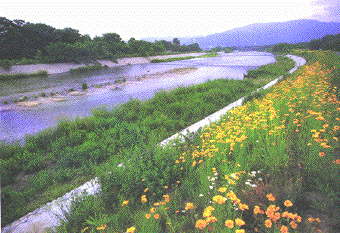ECO-FRIENDLY PUBLIC WORKS:
Conservation and Restoration Become Major Themes
OCTOBER 30, 1996

"Environment friendly" has become a guiding concept in recent public works projects. Today's river improvement projects are all aimed at restoring the environment for marine plant and animal life, and a significant number of road projects are aimed at reducing traffic accidents involving wildlife. A growing public awareness of environmental issues and desire among central and local governments to minimize the damage to the environment caused by development have played a major role in transforming the basic thinking on public works.
Retaining Rather Than Altering Nature
Until now, most river improvement projects involved shoring up river banks with concrete and building dams to prevent flooding and the collapse of embankments. However, in many cases such construction made it impossible for fish to swim upstream and marine plants to thrive, resulting in the disappearance of fish and destruction of the natural environment.
The new wave of river management projects grew from an awareness of these problems. This spring, the Sumida River became the site of a plan designed to cultivate marine plants to cleanse the water and recreate an environment for spawning.
The project, undertaken along the section of the river that runs alongside Tokyo's Asakusa district, called for constructing a mound of earth about 2 meters wide and 50 centimeters deep along the concrete embankment. The roots of reeds, sedges, and other marine vegetation were then planted there. At high tide the mound is submerged in water, creating an environment hospitable to the growth of plants.
If successful, the new vegetation will contribute to the purification of the water by absorbing nitrogen and phosphoric compounds in the river. Officials hope it will also provide an environment conducive to spawning.
Giving Rivers Back to the Fish
Two years ago Saitama Prefecture also turned away from a preoccupation with building concrete embankments for flood control and instead decided to create beds for spawning.
At the prefecture's Oba River, wire baskets measuring 40 centimeters long and 1 meter wide were filled with rocks about 15 centimeters in diameter, and the baskets were placed in the river in four layers, forming a diagonal four-tiered incline from the bank to the middle of the river. Carp, catfish, and other fish have subsequently laid their eggs between the rocks, transforming this part of the river into a habitat for young fish. Earth has also been deposited below the baskets at each layer, and vegetation planted there to create an amenable environment for fish and to contribute to the purification of the water.
Safeguarding Animals from Traffic Accidents
Various "eco-road" projects have also been completed. In Hokkaido, 89 traffic accidents in which deer were killed occurred on roads around Shiretoko National Park in the seven-year period from 1988 to 1994. Aiming to reduce the number of accidents and protect the animals' habitat, the prefecture put up wire netting on either side of a 2.4-kilometer stretch of a national highway--the scene of an especially large number of accidents--to discourage animals from traversing it.
A special bridge was also built so that deer could safely cross the highway. Since the completion of the project last year, no accidents involving deer have been reported, and confirmations have been made of deer using the bridge.
Meanwhile, a string of traffic accidents involving bears on a road at the foot of the Northern Alps prompted Gifu Prefecture to build a tunnel under the road for large animals, such as bears and deer. Completed this spring, the tunnel measures 3 meters high, 3 meters wide, and 26 meters long and resembles a natural trail used by wild animals. Humus has been spread along the ground, and the walls have been lined with beech tree logs to make animals less wary of using it.
A smaller tunnel was built under the same road last spring for jackrabbits, weasels, and other small animals. Footprints of rabbits and other animals have been discovered in it.
Growing Concern for the Environment
Environmentally friendly public works projects first appeared in the late 1980s and increased sharply in the early 1990s. By 1993 more than 3,000 such projects had been undertaken, both at the national and local levels.
One of the factors supporting this trend has been the Japanese public's growing interest in environmental preservation. In a 1994 public opinion poll conducted by the Prime Minister's Office, environmental conservation was cited as the area that should be given the highest priority in national land projects over the next two decades by the largest share of respondents, or 31%. This was 11 points higher than the percentage in 1983.
Moreover, when asked which they thought was more important, contact with nature or conveniences in daily life, 63% chose contact with nature, 6 points higher than in 1983, and only 32% cited conveniences, 3 points lower than 1983.
A similar transformation has taken place in attitudes at the government level. In its 1994 Environmental Policy Outline, the Ministry of Construction described its administrative goal as not only preserving the vitality and abundance of nature but also creating a gentler, richer, and more beautiful environment.
Today, priority is given in all projects to minimizing alterations to the natural environment. As a result, when a development project or the construction of a new facility is believed to lead to the disruption of the ecosystem through the loss of greenery or wildlife habitats, effort is made to mitigate these effects as much as possible.